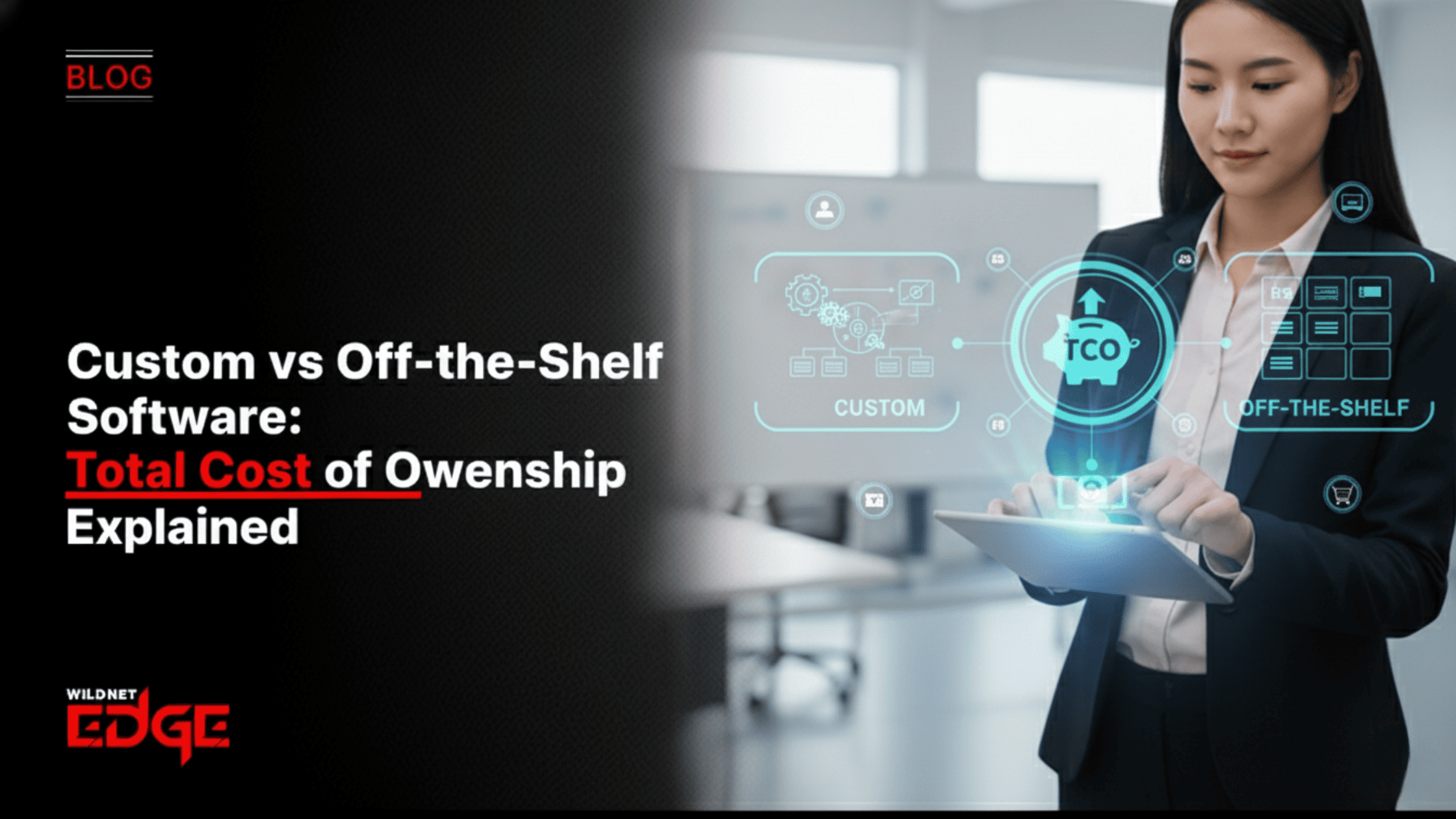TL;DR
This article delves into the critical custom vs off the shelf software decision, focusing on the Total Cost of Ownership (TCO) beyond initial pricing. It explains that while off-the-shelf (COTS) software appears cheaper upfront, hidden costs like customization, integration, and escalating subscription fees can significantly inflate the enterprise software TCO. Conversely, custom software’s higher initial investment often yields a lower TCO over time due to perfect workflow alignment, enhanced scalability, and lack of recurring license fees. The guide emphasizes analyzing factors like maintenance, training, and opportunity costs, concluding that a custom approach frequently offers superior custom app ROI and strategic value for businesses with unique needs.
One of the most fundamental technology decisions any business faces is whether to adapt an existing off-the-shelf software solution or invest in building a custom one. The build vs buy software debate often centres on the initial price tag, with off-the-shelf (COTS) options appearing significantly cheaper. However, this initial cost is only a small part of the picture. To make a truly informed strategic decision, leaders must analyse the Total Cost of Ownership (TCO), a metric that reveals the true, long-term financial impact of choosing custom vs. off-the-shelf software.
Understanding Custom vs Off-the-Shelf Software
- Off-the-Shelf (COTS): Pre-built software designed for a broad market, often sold via subscription (SaaS) or perpetual license. Examples include Microsoft Office, Salesforce (standard configuration), or QuickBooks.
- Custom Software: Software designed and built from scratch to meet the specific, unique requirements of a single organization. It is proprietary to the business that commissions it.
What is Total Cost of Ownership?
Total Cost of Ownership comprehensively assesses all costs associated with acquiring, implementing, using, and maintaining a software solution over its entire lifecycle. It looks far beyond the initial purchase price or development cost. A thorough enterprise software TCO analysis includes direct costs (like licenses and development fees) and indirect costs (like training, maintenance, and potential downtime). Understanding TCO is crucial for accurately comparing the long-term financial implications of custom vs off the shelf options.
Comparing TCO Components: Custom vs Off-the-Shelf
Let’s break down the key cost factors over the typical lifecycle of a software application.
| Cost Component | Custom Software | Off-the-Shelf Software (COTS) |
| Initial Cost | High (Development) | Low to Moderate (License/Subscription) |
| Customization | Included in initial build | Often High (Configuration, add-ons, workarounds) |
| Integration | Designed for seamless integration | Can be Complex & Costly (Requires connectors/APIs) |
| Data Migration | Planned during development | Can be difficult if data structures don’t match |
| User Training | Higher initially (unique system) | Lower initially (potentially familiar UI) |
| Maintenance & Support | Ongoing cost (Internal team or agency retainer) | Included in subscription (often basic); Premium support extra |
| Upgrades/New Features | Controlled by you; requires development effort | Dictated by vendor; included in subscription (usually) |
| Scalability Costs | Architected for need; Cloud costs scale | Can involve expensive tier upgrades or performance limits |
| Licensing Fees | None (You own it) | High & Recurring (Subscription or perpetual + maintenance) |
While COTS looks cheaper initially, costs related to customisation, integration, and escalating subscription fees over 3-5 years can often make the enterprise software TCO significantly higher than a custom build.
The Strategic Value: Calculating Custom App ROI
Beyond direct cost comparisons, the actual value often lies in the strategic benefits. Calculating custom app ROI involves quantifying factors that COTS solutions struggle to deliver:
- Productivity Gains: How much time does the tailored workflow save your employees compared to inefficient workarounds in a generic system?
- Competitive Advantage: What is the value of having a unique feature or customer experience that competitors cannot easily replicate? These tailor-made application benefits are hard for COTS to match.
- Scalability & Future-Proofing: What is the cost of being unable to scale or adapt quickly to market changes because your COTS platform is too rigid?
- Reduced Errors: How much does the custom system save by reducing manual data entry errors or process mistakes common with ill-fitting software?
A proper analysis often reveals that the strategic advantages and long-term efficiency gains result in a significantly higher custom app ROI. Getting help with this analysis is a key reason businesses seek a custom application ROI consultation.
TCO Considerations in Practice: Case Studies
Case Study 1: A Manufacturer’s ERP Decision
- The Challenge: A mid-sized manufacturing company with highly specialized production processes was evaluating a major off-the-shelf ERP system versus building a custom one. The COTS system appeared cheaper upfront.
- TCO Analysis: Our analysis revealed that customizing the COTS ERP to fit their unique workflows would require massive consulting fees, nearly doubling the initial cost. Furthermore, integrating it with their existing shop-floor hardware would be complex and expensive. The custom ERP, while costing more initially, offered a perfect fit, simpler integration, and no recurring license fees. Detailed ERP integration & scalability planning was crucial.
- The Result: The company chose the custom ERP. The enterprise software TCO over five years was projected to be 40% lower than the heavily customized COTS alternative. The bespoke system also delivered significant productivity gains.
Case Study 2: A Retailer’s eCommerce Platform
- The Challenge: A fast-growing online retailer was hitting the limits of their SaaS eCommerce platform. Tier upgrades were becoming prohibitively expensive, and they couldn’t implement the unique customer loyalty features they envisioned.
- TCO Analysis: While the initial cost of a custom headless commerce platform was high, the elimination of monthly platform fees and transaction percentages, combined with the projected revenue lift from the unique loyalty features, resulted in a lower TCO after just 18 months. This required expertise in modern enterprise app engineering.
- The Result: They invested in the custom platform. The enhanced scalability easily handled their growth, the unique features boosted customer retention, and the long-term TCO proved significantly lower than staying on the increasingly expensive SaaS platform.
Our Technology Stack for Custom Development
We build scalable, maintainable enterprise solutions.
- Backend: .NET, Java, Python, Node.js
- Frontend: Angular, React, Vue.js
- Databases: Microsoft SQL Server, PostgreSQL, MySQL, Oracle, MongoDB
- Cloud Platforms: Microsoft Azure, AWS, Google Cloud
- Integration: REST APIs, MuleSoft, Azure Logic Apps
Conclusion
The custom vs off the shelf decision requires a strategic look beyond the initial price. By carefully analyzing the Total Cost of Ownership and considering the long-term tailor-made application benefits, enterprises can make an informed choice that aligns with their financial and strategic goals. While COTS offers speed for standard needs, bespoke software development often provides superior long-term value, flexibility, and a higher custom app ROI for businesses with unique requirements.
Ready to explore if a custom solution is the right long-term investment for your enterprise? At Wildnet Edge, our AI-first approach ensures we build intelligent, scalable systems. We partner with you to develop a clear strategic product scaling roadmap and deliver solutions that provide a lasting competitive advantage.
FAQs
Often, yes, especially for standard functions like accounting or basic CRM. However, for the startup’s core product or value proposition, even an early custom MVP might be strategically smarter if off-the-shelf options severely limit differentiation or validation of the core idea. The build vs buy software analysis still applies.
Hidden costs often include: expensive customisation/configuration fees, costly integration connectors, data migration challenges, escalating subscription costs as you add users or features, premium support fees, and the opportunity cost of not having features that perfectly fit your workflow.
A thorough enterprise software TCO analysis absolutely should factor this in. Calculate the hours your employees spend fighting with ill-fitting software, performing manual data entry due to poor integration, or waiting for slow systems. This lost productivity is a significant hidden cost of COTS.
Not necessarily. While you are responsible for custom software maintenance (via internal team or agency retainer), COTS subscription fees often increase annually and can escalate dramatically if you need higher tiers or add-ons. Over 5-7 years, the total maintenance cost for a well-built custom app can be lower than perpetual COTS fees.
While major COTS vendors invest heavily in security, their widespread use makes them a larger target. A vulnerability found in a popular COTS product can affect thousands of companies. A custom application’s unique codebase presents a much smaller attack surface, and you have full control over implementing tailored security measures.
Yes, using an offshore team can significantly lower the initial development cost component of the TCO calculation for custom vs off the shelf, potentially making the financial case for custom development even stronger compared to expensive COTS solutions with high customization needs.
The best way is to engage with potential vendors for both options. Get detailed quotes for the COTS solution, including all necessary customisation, integration, and projected subscription fees over 3-5 years. Simultaneously, engage a custom development partner for a discovery phase to get a reliable estimate for building a tailored solution, including projected maintenance costs.

Nitin Agarwal is a veteran in custom software development. He is fascinated by how software can turn ideas into real-world solutions. With extensive experience designing scalable and efficient systems, he focuses on creating software that delivers tangible results. Nitin enjoys exploring emerging technologies, taking on challenging projects, and mentoring teams to bring ideas to life. He believes that good software is not just about code; it’s about understanding problems and creating value for users. For him, great software combines thoughtful design, clever engineering, and a clear understanding of the problems it’s meant to solve.
 sales@wildnetedge.com
sales@wildnetedge.com +1 (212) 901 8616
+1 (212) 901 8616 +1 (437) 225-7733
+1 (437) 225-7733































